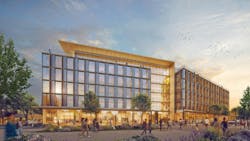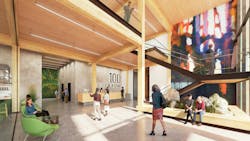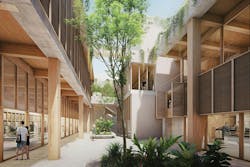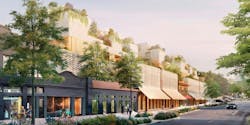5 hidden benefits of mass timber design
Mass timber is a materials and design approach that holds immense potential to transform the future of the commercial building industry, as well as our environment. The term refers to the use of advanced techniques to combine wood products in various layer formats to create structures that are strong and versatile.
This can be done multiple ways: gluing, nailing, or doweling. Mass timber serves as a low-carbon alternative to steel and concrete, with cross-laminated timber (CLT) and glulam being popular examples of contemporary mass timber products.
As a proponent of innovative design practices, Page is using mass timber for 100 Rock Row, an eight-story office building in Westbrook, Maine; and Sixth & Blanco, a five-story mixed-use development in Austin’s Clarksville neighborhood. 100 Rock Row is Maine’s first mass timber structure, striving to improve the wellness and productivity of its tenants by delivering 30% fewer carbon dioxide emissions. At Sixth & Blanco, Page serves as executive architect alongside Swiss firm Herzog & de Meuron. Mass timber will minimize the development’s carbon footprint and enhance its long-term strength and sustainability.
Here, discover a few exceptional benefits of mass timber design in construction.
1. Mass Timber Provides Fire Safety
Wood possesses unique fire-resistant properties. By leveraging its fire-resistant nature, CLT can be safely employed in taller structures. The International Building Construction Code recognizes the proven safety of mass timber and permits these structural types up to 18 stories. They undergo fire tests to determine the structural capacity lost per hour.
2. Enhanced Construction Capability
The prefabricated nature of mass timber components contributes to the ease and efficiency of construction, enabling quiet, fast, and clean jobsites. The controlled manufacturing environment and use of Computer Numerically Controlled (CNC) technology ensure precise fabrication, with pre-cut openings and predetermined assembly and fastening methods. This significantly reduces on-site labor and speeds construction.
3. Shallower Excavation
Compared to concrete, the lighter weight of mass timber reduces foundation requirements, resulting in shallower excavations and potential opportunities for vertical expansion of existing buildings.
4. Biophilia and Improved Human Health
Studies have shown the innate human affinity for nature positively influences behavior. Access to green spaces in affordable housing complexes reduces instances of domestic violence by approximately 25% compared to those without such access. Natural materials, especially wood, in interior spaces have a calming effect, lowering heart rates and activating the parasympathetic nervous system.
5. Agri-Business and Diverse-Species Forests
Mass timber construction advocates consider it part of a regenerative building industry. This supports the diversity of forests, which is crucial as monocultures of tree species do not foster long-term ecosystem health.
By embracing mass timber construction, we unlock numerous benefits beyond its capacity for carbon storage, inherent beauty, and renewability. To fully realize these advantages, designers prioritize responsible materials management and future disassembly and reuse. Responsible CLT construction can lead to healthier forests, soil, water, and air, all while enhancing the beauty of our buildings and satisfying our desire for connection with one another and with nature.



